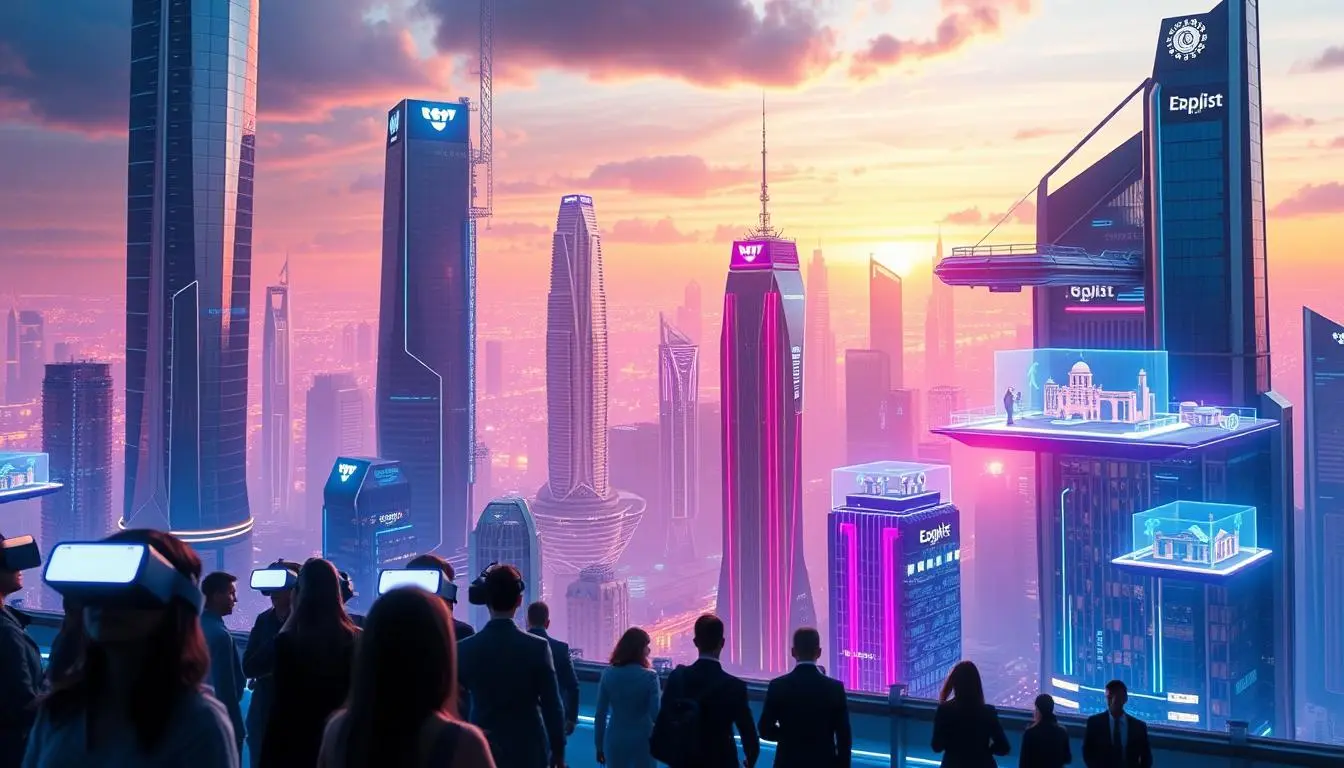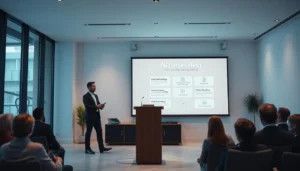NFTs In Metaverse: Exploring Virtual Real Estate Opportunities
A dynamic reimagining of digital participation is happening right now. Virtual reality and non-fungible tokens are reshaping our understanding of ownership and worth.
The metaverse has opened up a vast, immersive world. This platform enables novel forms of engagement between users and digital objects. Blockchain technology plays a key role, making transactions secure and transparent, and creating unique digital assets.

As you explore this new world, you’ll find opportunities for investment, creativity, and building communities. The convergence of NFTs and digital worlds is revolutionizing online interactions and economies. It offers a fresh take on digital ownership.
Table of Contents
Understanding the Metaverse Ecosystem
Exploring the metaverse means getting to know its world. A dynamic, interconnected realm where real-time collaboration thrives. This ecosystem spans immersive simulations, enhanced reality layers, and interactive social hubs.
What Defines the Metaverse
What sets the metaverse apart is its deeply engaging, participatory environment. Users can easily connect with digital assets and others. This is made possible by metaverse NFT projects, which allow for unique digital assets to be created, traded, and owned.
Key Components of Virtual Worlds
Virtual worlds in the metaverse have several important parts. These include digital land, avatars, and virtual goods. Transactions for these unique items occur on specialized digital trading platforms. This supports a lively economy for various activities, like gaming and socializing.
Major Metaverse Platforms Overview
Several big platforms are shaping the metaverse. Innovative metaverse hubs such as Decentraland, The Sandbox, and Somnium Space are driving the industry forward. They are building the virtual world economy and opening up new ways for users to explore the metaverse.
NFTs in Metaverse: Establishing True Virtual Ownership
NFTs are changing how we think about owning things in virtual worlds. As you explore the metaverse, knowing about NFTs is key. It helps you navigate this new digital world.
How NFTs Function as Digital Property Deeds
NFTs, or non-fungible tokens, are like digital certificates. They prove you own something special. Their blockchain verification ensures scarcity and authenticity. This lets creators sell their work directly to fans, cutting out the middleman.
Blockchain Technology Behind Virtual Assets
The heart of NFTs is blockchain technology. It makes sure transactions are safe and clear. This tech keeps NFTs safe and shows who owns them from the start.
The Evolution from Digital Art to Virtual Land
At first, NFTs were just for digital art and collectibles. Today, users can claim stakes in digital territories and beyond. This change has brought new ways to invest and be creative in virtual spaces.
As you go deeper into the metaverse, learning about NFTs and blockchain is vital. It helps you make smart choices about your digital stuff.
Virtual Real Estate: The New Digital Frontier
The metaverse is changing how we see property. Virtual lands and properties are now exchanged, developed, and personalized in thriving virtual markets. This opens up new chances for investment and creativity.
Owning virtual real estate in the metaverse provides exclusive governance rights over specific digital territories. It’s becoming popular because of metaverse NFT projects and NFT gaming. These are creating new places for virtual property.
Defining Virtual Land and Properties
These holdings signify legal claim over segments of immersive, computer-generated landscapes. They range from basic lots to intricately designed, interactive zones.
Types of Metaverse Real Estate Assets
Virtual real estate manifests in various formats, including:
- Plots of land for development
- Pre-built environments for various uses
- Specialized spaces for events or exhibitions
Here’s a comparison of different types of virtual real estate assets:
| Asset Type | Description | Potential Use |
|---|---|---|
| Plots of Land | Empty parcels for development | Building custom environments |
| Pre-built Environments | Ready-to-use spaces | Hosting events or exhibitions |
| Specialized Spaces | Designed for specific purposes | Nft gaming or virtual concerts |

Value Drivers in the Virtual Property Market
Scarcity, utility, and user interest drive the worth of digital land. As virtual reality gets better, these assets could become even more valuable.
Major Platforms for Virtual Real Estate Investment
With the rise of decentralized finance and NFTs, virtual real estate is now a popular choice. Several major platforms are now available for investing in virtual property.
Decentraland: The Pioneer of Virtual Land Ownership
Decentraland is a pioneer in virtual worlds. It lets users buy, sell, and manage virtual real estate with its own cryptocurrency, MANA. It has built a strong economy around virtual land.
The Sandbox: Gaming and Virtual Property Integration
The Sandbox empowers users to build and profit from customized three-dimensional worlds with interactive elements. Launched in 2015, it’s a favorite for gamers and investors. It combines gaming with virtual property.
Somnium Space and Other Emerging Platforms
Somnium Space merges VR immersion with a marketplace for digital parcels. Other new platforms are also growing, giving investors many options.
Comparing Platform Economics and Opportunities
When looking at these platforms, several things matter. These include their economies, user bases, and what experiences they offer. Here’s a table that summarizes these key points:
| Platform | Economic Model | User Experience |
|---|---|---|
| Decentraland | MANA cryptocurrency | Virtual land ownership |
| The Sandbox | SAND token | Gaming and user-generated content |
| Somnium Space | CUBE token | VR experiences and virtual land |
When thinking about investing in virtual real estate, it’s important to know what each platform offers. Whether you’re into the digital assets marketplace or NFTs in metaverse applications, these platforms have something for everyone.
How to Purchase and Manage Virtual Real Estate
To make money in the virtual world, you must know how to buy and manage virtual land. This includes several steps, like setting up a digital wallet and managing your virtual property.
Setting Up Your Digital Wallet
Securing a blockchain-based wallet is a prerequisite for purchasing virtual land. It should support the right cryptocurrencies and non-fungible tokens (NFTs). MetaMask and Trust Wallet are good choices, as they work with many blockchain platforms.
Navigating NFT Marketplaces for Land Purchases
Platforms like OpenSea and Rarible help you buy and sell virtual land. When you’re on these sites, look for properties that match your goals. Also, make sure the blockchain technology is secure.

Due Diligence for Virtual Property Acquisition
Doing your homework is key when buying virtual property. Learn about the property’s past, the virtual world economy, and its location in the metaverse.
Managing Your Virtual Real Estate Portfolio
After buying virtual land, managing it well is important. Keep an eye on market trends and think about crypto collectibles. You might also want to improve your properties to increase their value.
By following these steps and staying up-to-date with the metaverse, you can make smart choices. This will help you succeed in the virtual real estate market.
- Set up a digital wallet to start investing.
- Research NFT marketplaces for the best opportunities.
- Conduct due diligence on possible properties.
- Actively manage your virtual real estate portfolio.
Monetization Strategies for Your Virtual Properties
You can make the most of your virtual properties with different ways to make money. The metaverse has many chances to earn, like hosting events or renting out spaces.
Leasing and Renting Virtual Spaces
Leasing or renting out your virtual property is a simple way to make money. This works well in popular metaverse NFT projects where there’s a lot of demand. Leasing options include promotional placements, virtual gatherings, or workspace rentals.
Developing Commercial Venues in the Metaverse
Building commercial venues is another smart move. You can make shopping malls, concert halls, or other spots that people want to visit. These can make money through rental fees, ticket sales, or sponsorships. The goal is to create fun and unique experiences that people will want to see.
Hosting Virtual Events and Experiences
Hosting virtual events is becoming more popular in the metaverse. You can have concerts, conferences, or exhibitions on your property, drawing visitors from all over. This not only makes money but also boosts your property’s value and visibility.
Advertising and Brand Partnerships
Advertising and partnerships with brands are also good ways to make money. Brands want to be in the metaverse, and your property is a great place for them to reach people. You can work with brands to create sponsored content or ad spaces.
To understand the different ways to make money, here’s a comparison:
| Monetization Strategy | Revenue Potential | Initial Investment |
|---|---|---|
| Leasing/Renting | Moderate to High | Low |
| Developing Commercial Venues | High | High |
| Hosting Events | Moderate | Moderate |
| Advertising/Brand Partnerships | High | Low to Moderate |
By using different ways to make money, you can get the most from your virtual property investments. Whether you’re into NFT gaming, metaverse NFT projects, or just want to make money in virtual reality, there are lots of chances to explore.
Risk Assessment and Investment Considerations
When you step into the metaverse, knowing the risks of virtual real estate is key. The virtual world economy, fueled by NFTs and blockchain, offers chances but also hurdles.
Market Volatility and Liquidity Challenges
The virtual real estate market can swing wildly. Property values change with demand, platform fame, and mood. Be ready for your investment’s value to drop. Also, selling your virtual assets might take time.
Platform Longevity and Technological Risks
The platform’s life span is vital. Technological risks, like platform failure or policy shifts, can harm your investment. Check the platform’s team, community, and tech setup.

Regulatory Uncertainties in Virtual Economies
Virtual economy laws are changing and differ by place. Stay informed about regulatory and tax considerations for digital assets. Keep up with law changes to avoid risks.
By grasping these risks and investing wisely, you can tackle the metaverse’s virtual real estate challenges.
Case Studies: Success Stories in Digital Land
The metaverse is growing fast, and so are success stories in virtual real estate. You’re seeing a new time of investment chances, thanks to metaverse NFT projects and more interest in digital assets.
Major Land Sales and Record-Breaking Transactions
The metaverse has seen some amazing land sales, with prices hitting new highs. For example, a piece of land in Decentraland sold for over $2.4 million. This shows the growing value and chance of digital assets in the metaverse.
Corporate Brands Entering the Metaverse
Many corporate brands are investing in the metaverse, seeing its value for brand engagement and customer experience. Atari, for instance, is building a virtual theme park in The Sandbox. They’ll use $SAND, Atari tokens, and NFTs in the metaverse for payments and more. This move boosts the brand’s digital presence and opens new revenue paths.
Individual Investors Building Virtual Empires
Individual investors are also making their mark in the metaverse, with some achieving great success. Celebrities like Snoop Dogg have bought land and are creating virtual assets. This shows the chance for personal branding and investment in the digital world. You can check out various digital assets marketplace platforms to find chances that fit your investment goals.
These stories show the wide range of opportunities in virtual real estate, from big land sales to individual investor wins. As the metaverse keeps growing, we’ll likely see even more creative uses of nft tech and virtual properties.
The Future of Metaverse Real Estate Development
The metaverse is approaching a pivotal moment of transformation and expansion. It’s going to change how we see and use virtual real estate. Emerging innovations are poised to redefine virtual property landscapes.
Emerging Trends in Virtual Architecture
Virtual architecture in the metaverse is getting more advanced. Anticipate richer, more responsive virtual architectural designs. This is made possible by immersive digital environments and advanced spatial design tools. Some trends include:
- Hyper-realistic simulations that mirror physical existence
- Dynamic architecture that changes with user input
- Sustainable and eco-friendly virtual designs
Integration with Physical World Assets
The physical and virtual worlds are getting closer. You’ll see more links between metaverse real estate and real-world assets. This includes:
- Virtual versions of real properties
- Augmented reality that adds virtual info to real spaces
- Tokenized ownership of physical assets through blockchain technology
The Role of AI and Advanced Technologies
AI and other advanced tech are key in the future of metaverse real estate. Expect to see AI tools for:
- Automated property management and upkeep
- Personalized experiences through AI analytics
- Improved security with AI monitoring
As the metaverse grows, AI and other tech will unlock new chances and experiences in virtual real estate.
Navigating the Legal and Financial Aspects of Digital Ownership
The intersection of tokenized assets and virtual land is evolving rapidly. New compliance and taxation challenges arise with virtual holdings. Understanding these is key to smart investing and avoiding trouble.
Securing creative and proprietary rights is crucial in the Metaverse. Before purchasing digital assets, clarify the extent of your ownership rights. This includes the right to use, sell, or transfer them, and any platform or jurisdiction rules.
Intellectual Property Rights
It’s important to know the IP laws for your virtual assets. This includes copyright, trademark, and patent laws, which differ by place. Make sure your virtual property doesn’t break existing IP rights to avoid legal issues.
Tax Considerations for Digital Asset Investors
Taxes are a big deal too. In many places, NFTs and virtual real estate are taxed like property. You must keep good records of your buys and sells to figure out your taxes. Tax obligations differ depending on whether transactions are classified as an investor or a trader.
Navigating the Evolving Regulatory Landscape
The rules for NFTs and virtual real estate are changing and vary by place. Keeping up with these changes is important. They can affect the value and legality of your virtual assets.
As the metaverse grows, the laws and taxes will likely become clearer. But you must stay alert and adjust to any changes that might affect your investments.
Conclusion
You now know how big NFTs are in the metaverse and their impact on virtual reality. NFTs are more than just digital items. They mark a revolutionary change in how we establish and transfer digital ownership.
The metaverse is growing fast, with places like Decentraland and The Sandbox leading the charge. These virtual spaces open up new chances for investing, fun, and building communities. As you dive into this new world, think about the growth and challenges ahead.
As tech gets better, so will virtual real estate. You’ll see more uses of NFTs, better connection with virtual reality, and new trends in digital ownership. By keeping up with these changes, you can take advantage of the exciting opportunities in this fast-changing field.







